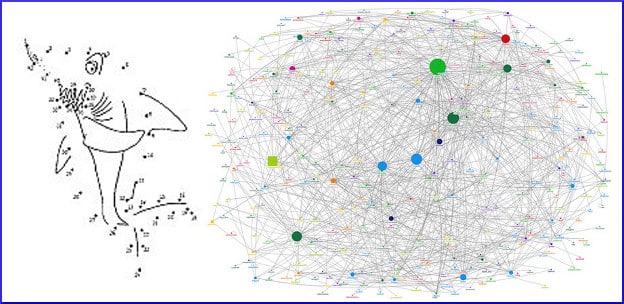 “Connecting the dots” is a figure of speech that applies to a mystery whose bits and pieces are scattered about and seem to make no sense at all. The phrase originated with picture puzzles made for small children. The object was to draw a line from one numbered dot to the next, which helps kids learn how to count, among other things. If the dots are connected in the right order, the big picture is revealed. The illustration on the page shown above, for instance, turns out to be a shark.
“Connecting the dots” is a figure of speech that applies to a mystery whose bits and pieces are scattered about and seem to make no sense at all. The phrase originated with picture puzzles made for small children. The object was to draw a line from one numbered dot to the next, which helps kids learn how to count, among other things. If the dots are connected in the right order, the big picture is revealed. The illustration on the page shown above, for instance, turns out to be a shark.
Nowadays, thanks to sophisticated graphics programs, we have another, equally useful conception of “connecting the dots.” Each factor in the puzzle has its own little circle, and they connect together in complicated ways. The dots don’t coalesce into a literal visual representation of a ducky or a shark, but they do tell a story to those with the skill to interpret it.
The mystery of the microbiome’s influence on childhood obesity fits well into that illustrative paradigm. A large number of factors are connected in labyrinthine ways. The microbiome is one of the dots, and so is obesity, and so are (to name just a few) diet, leaky gut syndrome, mental/emotional health, addiction, allergy, metabolic syndrome/diabetes, chronic inflammation, gestational influences, C-sections, antibiotics, and artificial sweeteners.
The extensive Childhood Obesity interview with Dr. Noel T. Mueller is titled “The Gut Microbiome and Childhood Obesity: Connecting the Dots.” Inside the human digestive tract live “tens of trillions of microorganisms,” mostly bacteria. Mueller says:
Gut dysbiosis, broadly defined as an imbalance of gut microbiota, has been associated with obesity and other metabolic disorders in humans…Beyond obesity, there is now a vast literature base showing that gut microbiota are associated with myriad infectious, autoimmune, and metabolic diseases.
To the best of our knowledge the microbiome’s two most important characteristics are diversity and balance. We need lots of different bugs, and we need them to get along with each other, as the best guarantee that they will get along with us. Plus, we know a bunch of scattered and seemingly disconnected things. Dr. Mueller has focused on events before and during the birth process, but is of course aware of all the other associated factors. When the interviewer asked him to name the missing link that would conclusively tie it all together, he suggested more investigation of every aspect:
This research is really nascent and it seems clear that we need more longitudinal studies in diverse populations that are large in sample size so we can not only determine temporality of associations, but also rule out confounding and start to understand interactions with genetic and environmental factors, as there are many modifying factors involved in the development of our microbiota and its effect on health and disease.
Rather than dots, all these factors could be seen as pieces of a giant jigsaw puzzle whose solution looks hopelessly daunting. On the other hand, there are many reasons to expect that eventually a complete and elegantly composed picture will be assembled. To put it another way, it’s like one of those English country-house mysteries where a large number of weekend guests all seem shady and suspicious. Who committed obesity?
It is important to connect the dots because, to quote a famous television series, “the truth is out there.”
Renowned author Michael Pollan looked at the research done by many scientists who are determined to pry loose this particular set of secrets and opined that…
…medical science may be on the trail of a Grand Unified Theory of Chronic Disease, at the very heart of which we will find the gut microbiome.
Your responses and feedback are welcome!
Source: “The Gut Microbiome and Childhood Obesity: Connecting the Dots,” mchtraining.net, June 2015
Source: “Some of My Best Friends Are Germs,” MichaelPollan.com, 05/15/13
Images:
justgrimes
MA MarineFisheries

 FAQs and Media Requests:
FAQs and Media Requests: 











